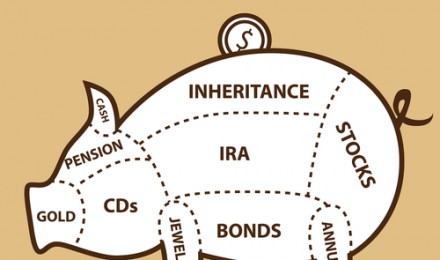Ideally every employer would provide a 401(k) or other pension for their employees. After all they are dedicating a significant portion of their lives to working for them. Unfortunately due to various circumstances this is not the case. When there are no retirement benefits offered through the employer, the employee still has plenty of options for saving for retirement on their own.
IRA
Starting in the 1980’s the best option for the individual to save for his or her own retirement was with an Individual Retirement Account (IRA). This popular choice was a great way for the individual to store up money in a tax deferred account for his or her retirement. The best part about these plans is that they are tax deductible, and if you are not covered by an employer plan, the income limit for deduction is even higher (see the IRS website for more information on deductibility). The downside to a traditional IRA is that the maximum contributions for 2012 are only $5,000.
Roth IRA
Similar to the traditional IRA, the Roth IRA is available as a way an individual can store up money in a tax advantaged account for retirement. While the traditional IRA allows contributions to be deducted from that year’s taxes, the Roth contributions go in after taxes are paid. The contribution limits are the same, but there are different income limits for eligibility.
Learn more about the differences between a traditional and a Roth IRA here and here.
Annuities
The two downsides to the IRA’s are that they have pretty low contribution limits, and they have income limitations that make it harder for high wage earners to contribute. There are options for those who cannot contribute to an IRA or who have maxed out their contributions. An annuity offered tax deferred growth, and can later be turned into a guaranteed income stream. The downside is that the money goes in after tax, and all earnings are taxed when they are taken out. The biggest advantage is that a variable annuity can be rebalanced without incurring any taxes. For those who are looking for another way to store money, a variable annuity is a good choice. Just be aware that they often have higher fees than a non-qualified account.
Non-qualified
If you are looking for a no-strings-attached place to store money, a simple non-qualified account might be the best option. Any interest or dividends earned in these accounts is taxed in the year they are earned. If mutual funds are sold, any gains in the account are taxed the year they are sold. That said, a non-qualified account is still a great way to accumulate money when some of the other options are not available.
For those who do not have access to a 401(k) or other employer sponsored plan, do not worry. There are plenty of ways to save for retirement using other tax advantaged ways. If you make too much, or have already saved enough to maximize an IRA, then you are doing well with your earning, and a non-qualified account or an annuity are the way to go. Regardless of the method chosen, you do have options.
Ideally every employer would provide a 401(k) or other pension for their employees. After all they are dedicating a significant portion of their lives to working for them. Unfortunately due to various circumstances this is not the case. When there are no retirement benefits offered through the employer, the employee still has plenty of options for saving for retirement on their own.
IRA
Starting in the 1980’s the best option for the individual to save for his or her own retirement was with an Individual Retirement Account (IRA). This popular choice was a great way for the individual to store up money in a tax deferred account for his or her retirement. The best part about these plans is that they are tax deductible, and if you are not covered by an employer plan, the income limit for deduction is even higher (see the IRS website for more information on deductibility). The downside to a traditional IRA is that the maximum contributions for 2012 are only $5,000.
Roth IRA
Similar to the traditional IRA, the Roth IRA is available as a way an individual can store up money in a tax advantaged account for retirement. While the traditional IRA allows contributions to be deducted from that year’s taxes, the Roth contributions go in after taxes are paid. The contribution limits are the same, but there are different income limits for eligibility.
Learn more about the differences between a traditional and a Roth IRA here and here.
Annuities
The two downsides to the IRA’s are that they have pretty low contribution limits, and they have income limitations that make it harder for high wage earners to contribute. There are options for those who cannot contribute to an IRA or who have maxed out their contributions. An annuity offered tax deferred growth, and can later be turned into a guaranteed income stream. The downside is that the money goes in after tax, and all earnings are taxed when they are taken out. The biggest advantage is that a variable annuity can be rebalanced without incurring any taxes. For those who are looking for another way to store money, a variable annuity is a good choice. Just be aware that they often have higher fees than a non-qualified account.
Non-qualified
If you are looking for a no-strings-attached place to store money, a simple non-qualified account might be the best option. Any interest or dividends earned in these accounts is taxed in the year they are earned. If mutual funds are sold, any gains in the account are taxed the year they are sold. That said, a non-qualified account is still a great way to accumulate money when some of the other options are not available.
For those who do not have access to a 401(k) or other employer sponsored plan, do not worry. There are plenty of ways to save for retirement using other tax advantaged ways. If you make too much, or have already saved enough to maximize an IRA, then you are doing well with your earning, and a non-qualified account or an annuity are the way to go. Regardless of the method chosen, you do have options.







